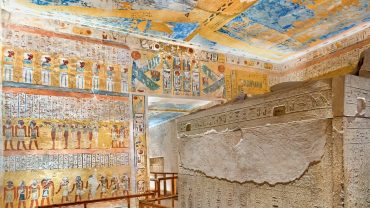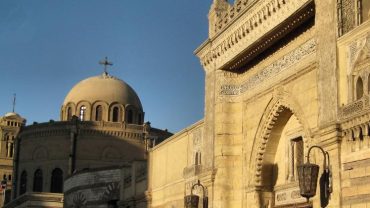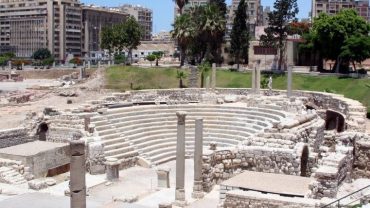The Tomb of Ramesses V in Valley of the Kings Luxor Egypt – KV 9 | facts Pharaonic Tombs, Tomb Plan, History The Tomb of Ramesses VI
The Tomb of Ramesses V & Ramesses VI KV 9
Who is Ramesses V & Ramesses VI?
The Egyptian Pharoah Ramesses V ruled Egypt during The New Kingdom of Ancient Egypt for a very short time, only four years (1145-1141 BC) and he was followed by his uncle Ramesses VI. The Pharoah Ramesses VI enjoy 8 years of reign and he is the only one who completed the KV9, the tomb of the previous king Ramesses V.
The strange point is according to a Hieratic papyrus in Turin, seems it was a civil war during Ramesses V’s short life and the Deir El Madina workers stopped digging his tomb. Meanwhile, there is an Ostracon mentioned that the king was buried in year 2 of Ramesses VI.
We already know that the Mummification was 70 days and the king should be buried direct after that, so what happened, and why he was not buried direct? We still have no answer
Anyhow, Pharoah Ramesses V’s mummy was found in the tomb of Amenhotep II (KV 35) with the mummy of Ramesses VI. Generally speaking, the Tomb of Ramesses V & Ramesses VI in the Valley of the Kings is one of the most beautiful tombs in the Valley.
Where is The Tomb of Ramesses V & Ramesses VI KV 9?
The Tomb of Ramesses V & Ramesses VI, KV9 in Egypt’s Valley of the Kings and is side by side with that of Tomb of Tutankhamun in the main Valley of Wadi Biban el-Muluk.
Facts about the Tomb of Ramesses V & Ramesses VI
- The Tomb of Ramesses V & Ramesses VI in the Valley of the Kings is one of the reasons why Tutankhamun tomb was saved and usurped by the tomb robberies.
- The tomb was built first for Ramesses V and it was used later by Ramesses VI.
- The tomb is famous for its beautiful pharaonic inscriptions and Pharaonic reliefs.
- Ramesses V & Ramesses VI tomb is one of the biggest in the Valley of the Kings, Luxor West Bank.
- The tomb shed some light on the art of the New Kingdom during the 20th Dynasty of Egypt
- Ramesses VI replaced the names of his predecessor Ramesses V with his name.
- The first part of the tomb still keeps the inscriptions for Ramesses V
- KV 9 has a lot of graffiti which means it was known since antiquity.
- Scholars of the Napoleonic Expedition called it La Tombe de la Metempsychose
- Romans called it the tomb of Memnon
- George Daressy cleaned the sand and debris of the tomb in 1888
- Every corridor has astronomical ceilings
- The length of tomb is 116 meters long
- Sun reliefs are the theme of the tomb.
- Papyrus Mayer B was found inside the tomb and it talks about the robbery of the Pharaonic tomb during antiquity
Ramesses VI sarcophagus
The sarcophagus of Ramesses VI has been smashed into 360 pieces and the Theban Mapping Project Egyptologist Edwin Brock accepts the challenge to recollect the available pieces.
Brock has a good experience in Luxor as he began work in the Valley of the Kings in 1985. However, he worked at Tomb of Merenptah, Ramesses VI, and Ramesses VII. The sarcophagus was in a very bad condition as some pieces were not in Egypt.
For example, Giovanni Belzoni took the mask for Henry Salt, the British consul-general in Cairo. Salt, in turn, was sold to the British Museum in 1823.
Brock and his team spent the first season trying to figure out the measurements of the sarcophagus. Moreover, he requested the conservation department of the British Museum to deliver a fiberglass replica of the sarcophagus mask in time for 2002.
After receiving the mask replica produced by the British Museum and with the help of his team, they did it. They restored the mummiform sarcophagus of Ramses VI which we can see now in KV9. Finally, the sarcophagus of Ramesses VI is made out of red granite and it was decorated with the Book of Earth and Isis and Nephthys.
Who is the discoverer of the Tomb of Ramesses V & Ramesses VI KV 9?
Ramesses VI reigned for 8 years and sure after his death, he was buried inside his tomb kv9. Years later, during the reign of Pinedjem I, the mummy was moved to KV 35. Somehow, the tomb was known since antiquity till it was rediscovered by victor Loret in 1988.
Restoration work in The Tomb Ramesses VI
Since Victor Loret discovered the tomb in 1988 and Edwin Brock collected and restored the sarcophagus of Ramesses VI between 2001 and 2004, the tomb is open for the visit but against the charge.
Tomb Plan
- Entryway
- First corridor
- 2nd corridor
- 3rd corridor
- Well Shaft
- Pillared room
- 4th corridor
- 5th corridor
- Anti-chamber
- Burial chamber
- Small chamber after the burial chamber
More details about the Tomb of Ramesses VI
MEASUREMENTS
- Maximum height: 6.93 m
- Minimum width: 2.48 m
- Maximum width: 13.04 m
- Total length: 116.85 m
- Total area: 510.07 m²
- Total volume: 1572.26 m³
Decoration of the Tomb of Ramesses V & Ramesses VI
- Painting
- Sunk relief
Tomb Robberies at the End of the New Kingdom
Tomb robbing in ancient Egypt was recognized as a serious problem since antiquity. Tutankhamun’s tomb gave us a perfect example of what we can find inside a royal tomb. That was the reason why the tombs were targeted for tomb robberies right after burying the kings. Ramesses VI tomb was one of these tombs and all the tomb treasures were totally stolen by the thieves of the cemetery.
The inscriptions of the Tomb of Ramesses V & Ramesses VI | Tomb reliefs
Entryway
It is a unique entrance to this Pharaonic Tombs as it slopes gradually from the valley floor by more than 20 meters. The gate is decorated on both sides with the names and titles of the king. At the top of the entrance like the Merenptah tomb and The Tomb of Rameses III, there is a circle and inside it is the Ram-headed god with a scarab.
Goddess Isis and Goddess Nephthys are in a kneeling position on both sides of the disc for protection. The entrance still keeps 19 Greek graffiti on the left wall and two graffiti on the right wall. Besides, one Anatolian graffiti on the right wall and an ancient Workplan on the left wall.
1st corridor
This first corridor slopes gently to the next one and its walls are decorated with reliefs representing Ramesses VI (replaced Ramesses V) in front of Ra Horakhty and Osiris. Then, the representation of the 2nd, 3th, and 4th hours of the Book of the Gates.
The right wall shows the Pharoah offering incense to Ra-Horakhty and Osiris plus scenes from the Book of Caverns with an astronomical ceiling. On the left wall of this corridor, there are 176 Greek graffiti on the left wall, One Latin and One Demotic graffiti, and one Phoenician. While, are 73 Greek graffiti, two Anatolian, one Demotic, and One Hieratic on the right wall.
2nd corridor
This corridor has 2 small side chambers on both sides and they are high in the wall. The left one has reliefs of the third division, fourth hour, of the Book of Gates. The rest of the left wall has the 4th, the 5th, and the 6th hours of the Book of the Gates.
The right wall is decorated with the 2nd and the 3rd divisions of the Book of Caverns. The ceiling of this corridor is an astronomical ceiling.
54 Greek graffiti and one Latin on the left wall while the right wall has 70 Greek graffiti, one Coptic, One Latin, and one Demotic.
3rd corridor
The corridor ends with a ramp and 2 very small side chambers facing each other at the end of it. The left wall is decorated with scenes from the Book of Gates. Side chambers carry scenes from the The Book of the Heavenly Cow.
The right wall and its side chamber carry scenes from the Book of Caverns.
The ceiling is depicted with the famous figure of the Goddess Nut, the goddess of the Sky bending over two registers representing the beginning of the Book of the Day and the end of the Book of the Night.
There are 94 Greek graffiti on the walls of this corridor.
Well Shaft
This well-shaft is decorated with scenes from the Book of Gates, and Book of Caverns while the ceiling is decorated with reliefs from the Books of the Day and the Night.
There are 28 Greek graffiti, 3 Latin, and one Phoenician on the left wall while the right has 7 Greek graffiti.
Pillared Room
The room has 4 pillars and it is divided into two halves by descending ramp in the middle. The left wall is decorated with the last chapters of the Book of Gates.
The right wall shows the Book of Caverns plus scenes show the Pharaoh making libation in front of Osiris.
The 4 Pillars scenes show Rameses VI before Khonsu, Amun-Ra, Meretseger, Ptah-Sokar-Osiris, Ra-Horakhty, Ptah, and Thoth.
The central portion of the ceiling show Nut, goddess of the sky, and inside her body the end of the Book of the Day and the beginning of the Book of the Night.
37 Greek graffiti on the left wall with one Arabic and one Latin graffiti while there are 12 Greek graffiti on the right wall.
4th corridor
The left wall shows the first and second hours of the Imydwat from the top while the right wall shows the sixth and seventh hours and the beginning of the eighth hour of the Imydwat.
The ceiling displays diagrams of the solar boat and its components.
There are 30 Greek graffiti and two Latin on the left wall while on the right wall we have 38 Greek graffiti and one Coptic.
5th corridor
The walls of this corridor show scenes from Imydwat while the ceiling contains enigmatic scenes with cryptographic texts.
On the left wall, we can see 46 Greek graffiti and one Latin while on the right wall we have 22 Greek graffiti.
- Anti-chamber
Mostly decorated with scenes from the Book of the Dead and the kings in front of different deities such as Maat and Heka. The ceiling shows the resurrection of Osiris and the barks of the Day and Night. Only 12 graffiti on the right wall of this anti-chamber.
Burial chamber
The burial chamber has 4 pillars and the scenes on the four pillars show Rameses VI with Maat, Ptah-Sokar, Anubis, Meretseger, Osiris, and Ptah. The Book of the Earth is portrayed here also.
The ceiling here has one of the most amazing representations of the goddess Nut, two figures back-to-back framing the Books of the Day and the Night.
The left wall has 20 pieces of Greek graffiti and one Latin while the right wall has 34 Greek graffiti, one Latin, and one Hieratic.
The sarcophagus is made of red granite and is in a pit inside the burial chamber.
Last room
The end of the tomb was never finished but we can see some relief from the Book of Gates and the king in a kneeling position.
The walls are covered with 32 Greek graffiti, one Latin, and one Demotic.
Opening Hours
As long as the tomb of Ramesses V & Ramesses VI is one of the Valley of the Kings’ tombs, the visiting hours to the tomb are the same as the opening hours of the Valley of the Kings. Valley of the kings is open daily from 06.00 am to 17.00 pm but ticket windows close at 16.30 pm. That means you can visit the tomb daily between 06.00 am to 17.00 pm.
How much is the Tomb of Ramesses V & Ramesses VI ticket?
kindly put in your mind that you will need to purchase two tickets. Entrance ticket for the Valley including access to 3 tombs and a ticket for the electric car. Ticket windows are next to each other. The entrance ticket includes 3 opened tombs and Ramesses V & Ramesses VI tomb is not included in the ticket. This means, you need to purchase a different ticket for this tomb
Adult: EGP 100 (6 $)
Students with valid cards: EGP 50 (3 $)
Children aged 6-12 years: EGP 50(3 $)
Children under 6 years: FREE
Tips for visiting the Tomb of Ramesses V & Ramesses VI KV 9
- The first piece of advice we can tell, visit the valley of the Kings and the tomb of Merenptah with an archaeologist guide. They will provide you with a detailed explanation of the development of the tombs from the hole underground to the Pyramidical shape of the tombs in the Valley.
- Read before you go
- Take extra water with you and some snacks, especially in the summer months, and drink at least 5 small bottles of mineral water to not hydrate.
- Small change for the WC
- Do not forget to take your hat, sunglasses, and suncream with you
- Cotton dress during summer
- There is a café facing king Tutankhamun’s tomb in the valley of the kings if you like to drink something or have an ice-cream
Kindly Note:
That was a brief idea about a pharaonic tomb of one of the Ancient Egyptian civilization Pharaohs and an example for one of the Pharaonic tombs in the Valley of the Kings. If you like to visit more Pharaonic tombs and learn more about the best things to do in Luxor, Egypt Palma Tours highly recommend
- KV2 The Tomb of Ramesses IV
- KV6 The Tomb of Ramesses IX
- KV11 The Tomb of Ramesses III
- KV14 Tausert and Setnakht
- KV8 Merenptah tomb
If you like to know about the best tombs you can visit against the charge, here are the three extra ones
- KV9 – Ramesses V, Ramesses VI
- KV17 – Seti I
- KV62 – Tutankhamun
That was about the Valley of the Kings and the Pharaonic tombs but if you like to know more about Egyptian history, ancient Egyptian civilization, and Pharaonic temple, we recommend the following sites
Ramesseum
If you are in of Egypt tour packages, Nile Cruise Luxor Aswan or enjoy some multi days in Luxor, explore top Luxor tourist attractions such as when booking Private Luxor Day Trip From Marsa Alam.
Deir El Madina (City of the workers)
Tombs of Nobles
Tomb of Nakht
The Tomb of Menna
Luxor Museum
Mummification Museum in Luxor




Comment (0)